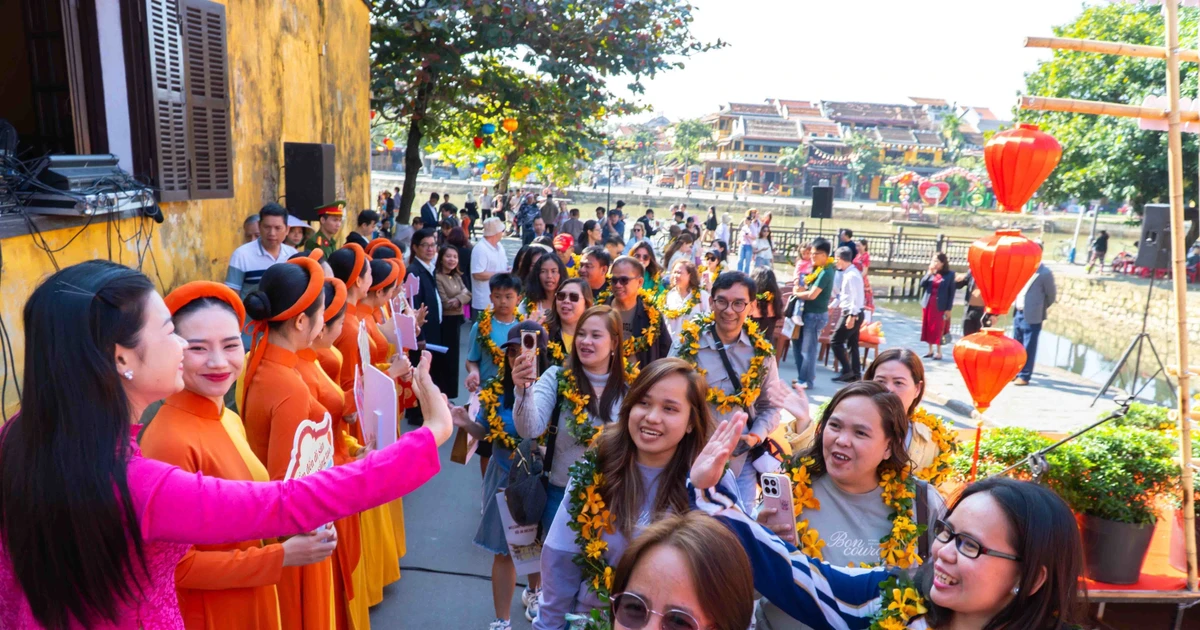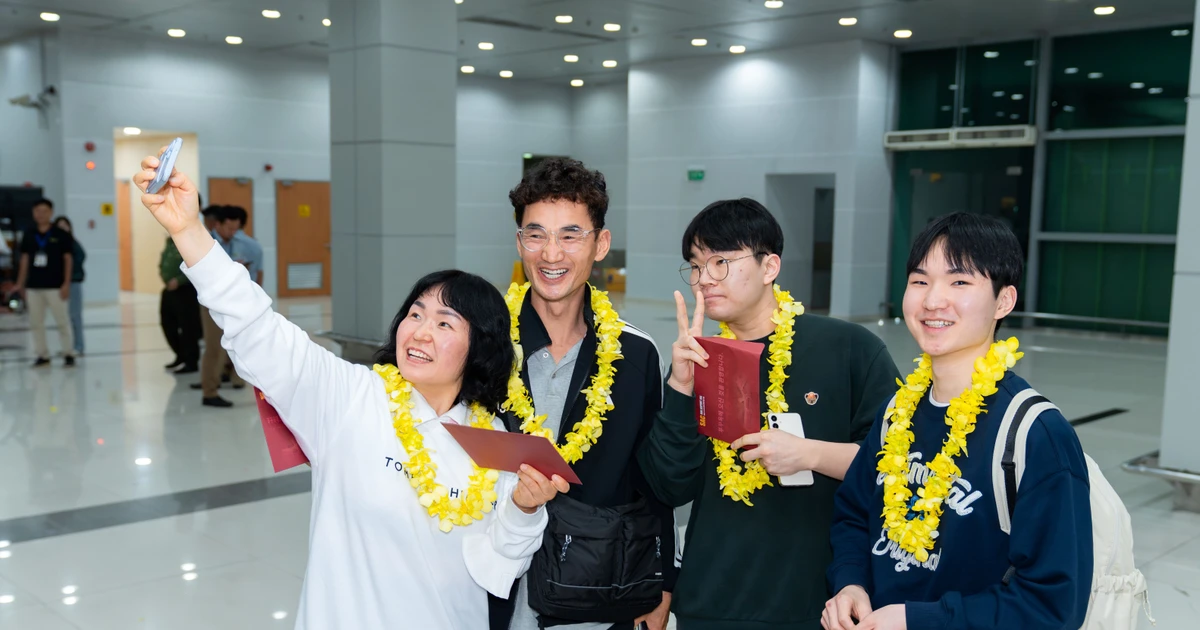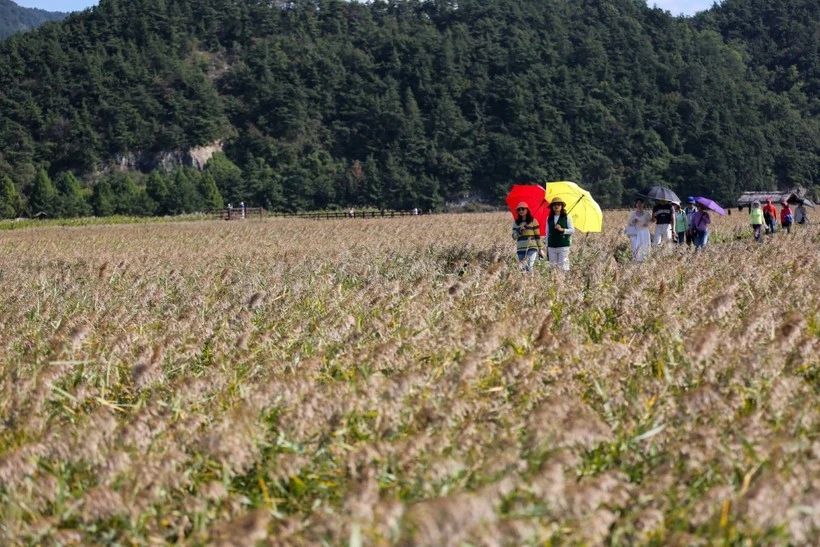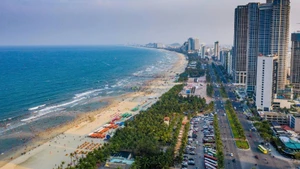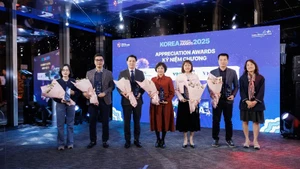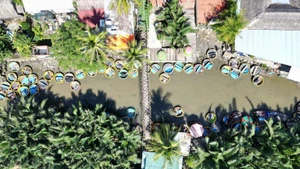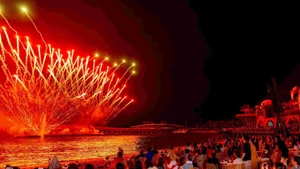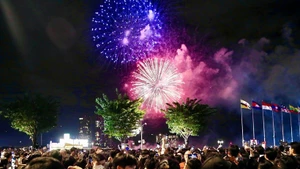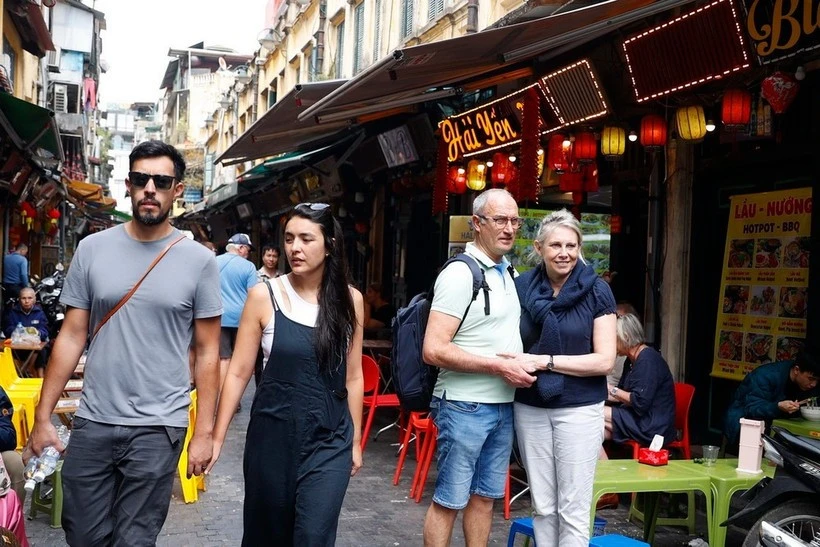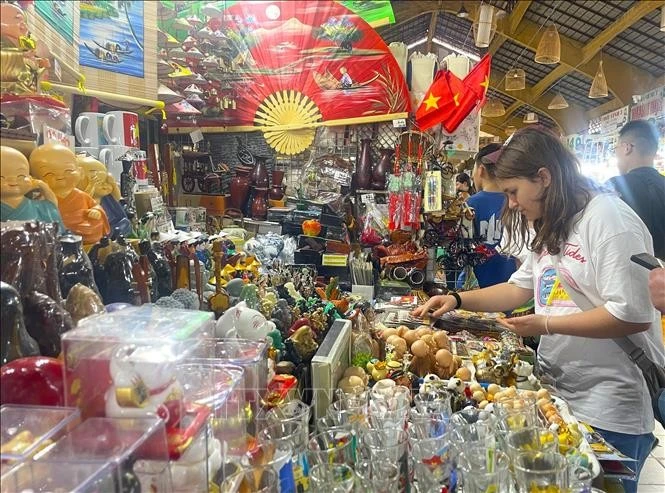New experiences
During the recent National Day holiday, at the “Tran House” space in Quang Ninh Museum, Mai Huy Duc from Ha Noi took his family for a visit and tried on an automatic-audio-guide headset.
After a few minutes of listening, he shared: “In the past, when visiting museums, I often only looked at artefacts and read the short information outside the glass cases. Now, with a clear and easy-to-understand audio guide, I feel I have a deeper understanding of the history, culture, people, and land I am visiting. It is no longer as dry as before.”
For many Vietnamese tourists, it was their first time experiencing such a modern form of interpretation within a traditional exhibition space.
Not only domestic visitors but also many foreign tourists to Quang Ninh were delighted to try scanning QR codes at Tra Co Communal House or Xa Tac Temple. With a simple action, they could access audio guide content in English, Korean, Chinese, and more.
One foreign visitor commented: “What I like most is the convenience. No need for anyone to interpret, the information appears directly on my phone — fast and visual.”
Meanwhile, during a field trip by a group of secondary school students from Ha Noi, their excitement was evident. They said that listening to audio guides with illustrated images made the visit feel like a “history lesson with technology” and was much more vivid and easier to remember.
Thanks to the multilingual audio guide application, seemingly silent artefacts — from the Ngoa Van golden box to the Thai Lang stupa — have become more approachable and lively. It is therefore not surprising that Quang Ninh Museum welcomes 750,000–800,000 visitors every year.
Do Quyet Tien, Director of Quang Ninh Museum, said that in the coming time, the museum will continue to work with relevant units to adjust exhibition spaces and apply digital technology solutions to offer visitors more experiences and discoveries.
Beyond museums, technology is also present at many other destinations. In Ha Long Bay, e-ticket software helps reduce crowding; at Yen Tu, e-tickets have replaced traditional ticketing, which has been saving time and enabling tighter management. In Ha Long City, a smart cruise management system is being piloted to regulate routes and reduce congestion during peak hours.
These applications have opened a new approach: integrating technology into tourism life, making visitors’ journeys more convenient, modern, and full of experiences.
A synchronous starting point
Assessing the initial changes in the digital transformation journey, Nguyen Lam Nguyen, Deputy Director of the Department of Culture, Sports and Tourism of Quang Ninh Province, said the province had proactively laid a solid foundation with data — considered the “brain” of smart tourism.
The province has built and put into operation four major databases: accommodation facilities, travel enterprises, tour guides, and the network of tourist areas and sites. This is not just a collection of fragmented information but has been standardised and regularly updated, enabling management agencies to monitor operations more effectively, businesses to connect with partners more easily, and visitors to access official and transparent information.
In addition, the department has proposed adding two new data segments: visitor statistics and tourism product statistics. These two new pieces are expected to complete the real-time management system, accurately reflecting market supply and demand and enabling timely policy decisions.
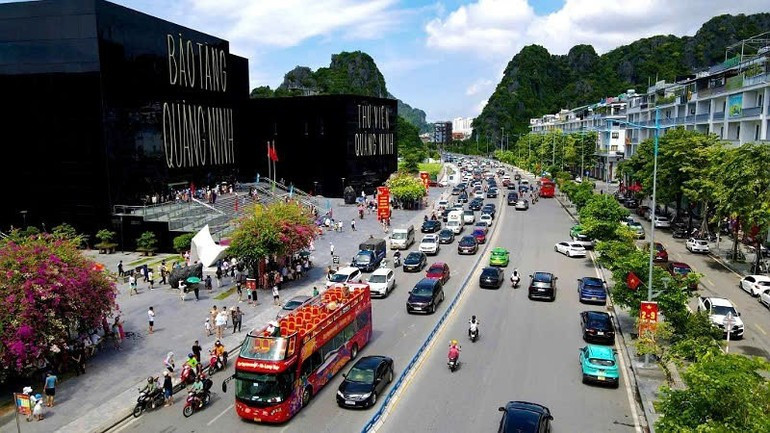
Alongside data, many modern technology applications have been deployed. The province is piloting heritage site management software to enhance transparency in operations, encouraging the use of virtual reality (VR) and augmented reality (AR) in heritage promotion to improve experiences, especially for young and international visitors.
The e-ticketing systems at Yen Tu and Quang Ninh Museum, which are now being expanded in Ha Long, are considered a significant step forward, saving time and providing better visitor control while preventing revenue loss.
At the same time, training and human resource development have been prioritised. Nguyen Nghia, a tour guide at a Ha Long travel company, shared: “In the past, managing tour groups was very manual, often causing confusion and delays. After training, I learned to use software to update information and interact with visitors online. Everything is quicker and much more professional now.”
These concrete stories show that technology is not just a slogan but has truly entered the daily work of those engaged in tourism.
Another noteworthy advance has been overcoming “wave depression zones” in Ha Long–Bai Tu Long Bay, which once caused difficulties for both tourists and businesses. Thanks to cooperation with major telecom providers, the entire area is now covered by telecommunications, creating a foundation for synchronised digital services such as ticket booking, online guides, and safety alerts right on the bay.
At the same time, the province is also working to build a smart cruise management system. Instead of manual coordination, the system will automatically monitor traffic, regulate routes, and allocate vessels during peak hours — a solution that is expected to ease congestion and ensure safety.
All these efforts demonstrate that Quang Ninh is taking its first steps towards creating a civilised and modern tourism environment.
Bottlenecks and solutions in the digital transformation journey
Although initial achievements have been made, Quang Ninh’s tourism digital transformation still faces many challenges. With a vast area covering high mountains and offshore islands, telecommunications and technology infrastructure cannot yet reach everywhere, leaving gaps in digital connectivity.
In many island communes, internet use is still unstable, leading to incomplete application of online booking, automatic interpretation, or safety alerts.
Beyond infrastructure, human factors are also a barrier. Thousands of small accommodation facilities and family-run guesthouses managed by elderly people still operate manually with little exposure to technology.
A homestay owner in Binh Lieu admitted: “I have heard about digital transformation and find it interesting, but I am not even proficient with a smartphone, let alone software or applications.” Meanwhile, small and medium-sized enterprises, which make up the majority of the province’s tourism sector, face financial difficulties and lack resources for equipment and staff training.
Some key projects once expected to provide a boost, such as the smart tourism city project in Ha Long, have been delayed due to institutional and administrative bottlenecks.
Leaders of the culture–sports–tourism sector candidly acknowledged that digital transformation has created visible changes but cannot yet be considered the decisive factor for Quang Ninh tourism. This indicates that Quang Ninh needs synchronised infrastructure, decisive implementation and the participation of the whole society.
To overcome challenges and achieve the goal of becoming an international-class smart tourism hub, Quang Ninh has defined a comprehensive system of solutions, linking the provincial level with the grassroots, from management agencies to enterprises and communities.
According to Nguyen Lam Nguyen, Deputy Director of the Department of Culture, Sports and Tourism of Quang Ninh Province, the completion of digital data is considered a key step. The four existing databases — accommodation, travel, tour guides, tourist sites — will be standardised and interconnected, while visitor and product statistics will also be added.
When operated in real time, this will become the “centre” for managing the sector with digital evidence, while providing transparent, official information for tourists and businesses.
In parallel, Quang Ninh is focusing on applying modern technology. The e-ticketing system will be expanded from Yen Tu and Quang Ninh Museum to other key tourist destinations; heritage management software and VR/AR applications will help promote heritage more vividly.
The province is also accelerating the use of AI chatbots and big data analytics to forecast market trends and personalise tourist experiences.
In terms of infrastructure, Quang Ninh will ensure comprehensive telecommunications coverage. Another pillar is the improvement of human resources. In the coming period, the province will expand training, cooperate with educational institutions, and encourage businesses to develop “reskilling” roadmaps for staff and tour guides.
More importantly, Quang Ninh stresses the mechanism of social mobilisation and public–private partnership (PPP). The state will play a facilitating role, establishing the legal framework, data platforms and digital infrastructure, while technology and travel enterprises develop digital applications and products.
People will both benefit and directly participate, from providing services and OCOP products to promoting destinations via social networks.
In addition, the province also attaches importance to regional and international linkages. Action plans emphasise promoting Quang Ninh’s image at international fairs and forums, expanding cooperation with Japan, the Republic of Korea, Guangxi (China), and so on. The Ha Noi–Hai Phong–Quang Ninh triangle will continue to be strengthened, linking transport infrastructure (expressways, Van Don Airport, the international passenger port) with a comprehensive smart tourism system.
It is clear that the solutions Quang Ninh is implementing do not stop at a few isolated applications but form a synchronous strategy of data–technology–infrastructure–human resources–policy. All solutions aim towards the common goal of deeply integrating technology into every experience, not only causing tourism to surge but also making it truly high-quality, civilised, and sustainable.


